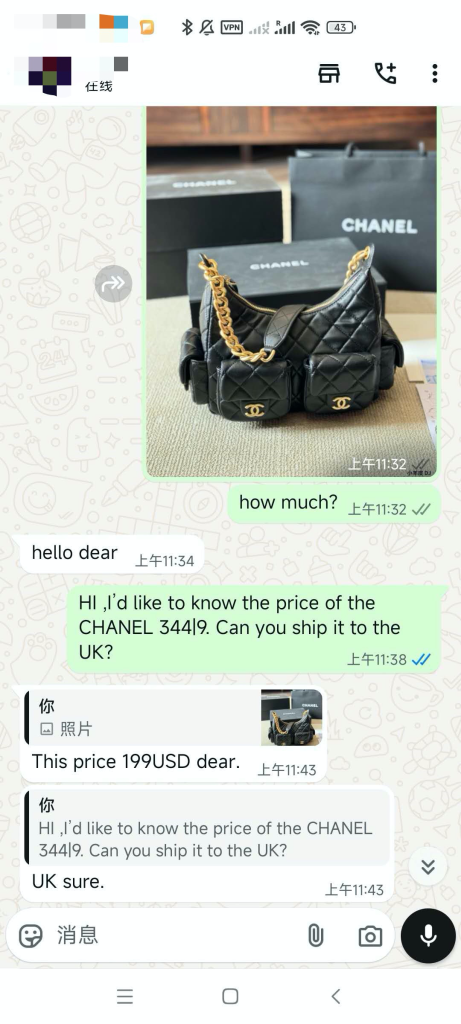Summary
In this post, I share my recent experience uncovering just how deep the replica bag market runs on TikTok—and how a seemingly affordable US-$199 “genuine leather” find turned out to be sourced at just RMB 240 in China.
A little while ago, I published a blog about replica-bag grades: The Various Grades of Replica Handbags
). In that post, I broke down the distinctions between:
- Top-Grade (Authentic Grade and 1:1) replicas made with factory-original materials or imported high-quality materials.
- Mid-Grade(AAA+ Grade) premium Chinese leather or standard imported materials.
- Low-Range (A and B Grade) options using China-made faux leather.
Today’s story picks up from there—I was scrolling through TikTok when I stumbled on a live stream selling replica bags at prices so low I couldn’t believe it.
Discovery on TikTok
Live-Streaming Seller
While browsing TikTok, I noticed a live broadcast featuring dozens of replica designer bags displayed on a table. Intrigued by the host’s flashy presentation and the promise of steep discounts.
Within minutes, the seller flashed a WhatsApp contact link in their TikTok. I tapped through, saved their number, and—after a brief greeting on WhatsApp—asked for details on one particular bag that caught my eye.
Initial WhatsApp Inquiry
I selected a bag at random from the seller’s Yupoo album and sent them a message:

That price—just under two hundred dollars for “genuine leather”—seemed almost too good to be true. So I dug deeper.
Price Verification via Reverse Image
Szwego Album Search
To verify the seller’s claim, I downloaded the product image and used Chna replica seller platform “微购相册” (Szwego Album) for a reverse-image lookup. Within seconds, I found a domestic supplier offering the exact same photo:

- Domestic cost: RMB 240 (about US-$34)—no mistake, that’s Chinese yuan, not U.S. dollars.
Seeing that massive gap between the supplier price and the TikTok offer made me skeptical about both the claimed leather quality and the seller’s markup.
Panda Factory Comparison
For further context, I looked up the same model from the well-known “Panda Factory,” famous for their high-quality replicas (their boxes even sport a little panda logo). The listed price there was:

- Panda Factory price: RMB 1,580 (≈ US-$220)
Market Dynamics: Why High-Quality Sellers Fade
Price Wars Favor Low Quality
In the replica-bag market, high-quality sellers typically add a modest markup—say, 30–50% over factory cost—to cover materials, craftsmanship, and shipping. In contrast, some low-quality vendors simply apply a 6× multiplier to the wholesale cost. Even if half of their orders are returned (implying a 50% return rate), they still net far more profit per successful sale than the high-quality sellers do.
Advertising Muscle on TikTok
With larger profit margins, low-quality sellers reinvest heavily in marketing:
- Purchasing multiple TikTok accounts for round-the-clock live streams
- Running aggressive ad campaigns targeted at impulse shoppers
Meanwhile, reputable artisans and higher-grade replica producers can’t sustain those ad budgets, nor can they compete with rock-bottom price tags. As a result, shoppers scrolling TikTok are far likelier to encounter these cut-rate merchants, even though their products often fall short in durability and finish.
Conclusion
My US-$199 TikTok find illustrates a broader truth: in the replica-bag ecosystem, extreme markups on ultra-low sourcing costs give low-quality sellers a marketing edge that pushes out responsible, quality-focused merchants. Before you’re tempted by that unbelievably low price tag, consider doing your homework:
- Reverse-image search the listing photos.
- Looking for advice from people with experience buying high-quality bags, or hoping to learn more from related forums.
- Weigh the trade-off between price and craftsmanship—cheap isn’t always cheerful.
By taking these steps, you’ll be better equipped to spot true 1:1 replicas rather than the bargain-basement bargains that often disappoint. Happy shopping—and stay savvy!